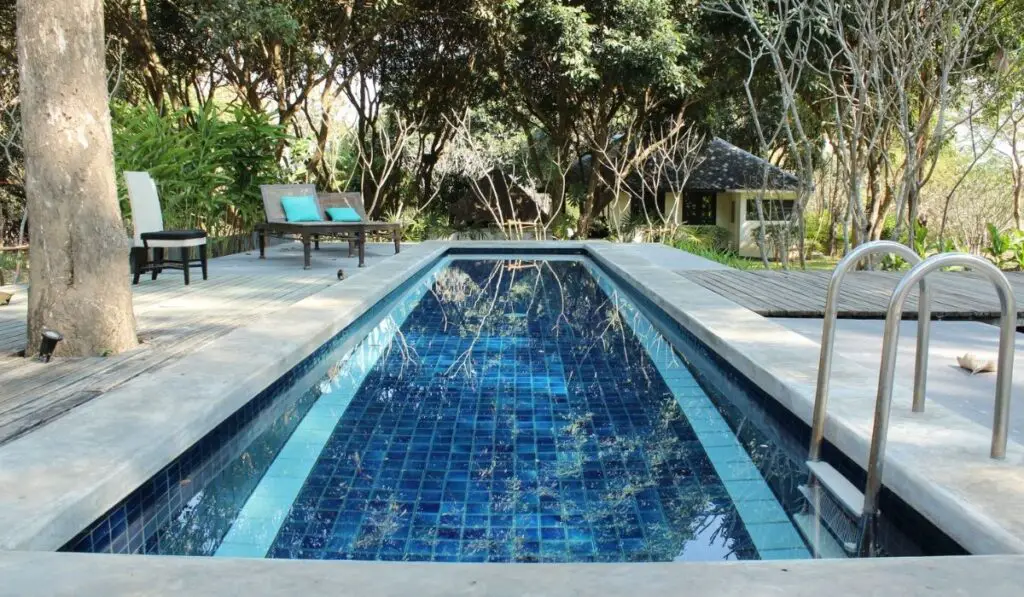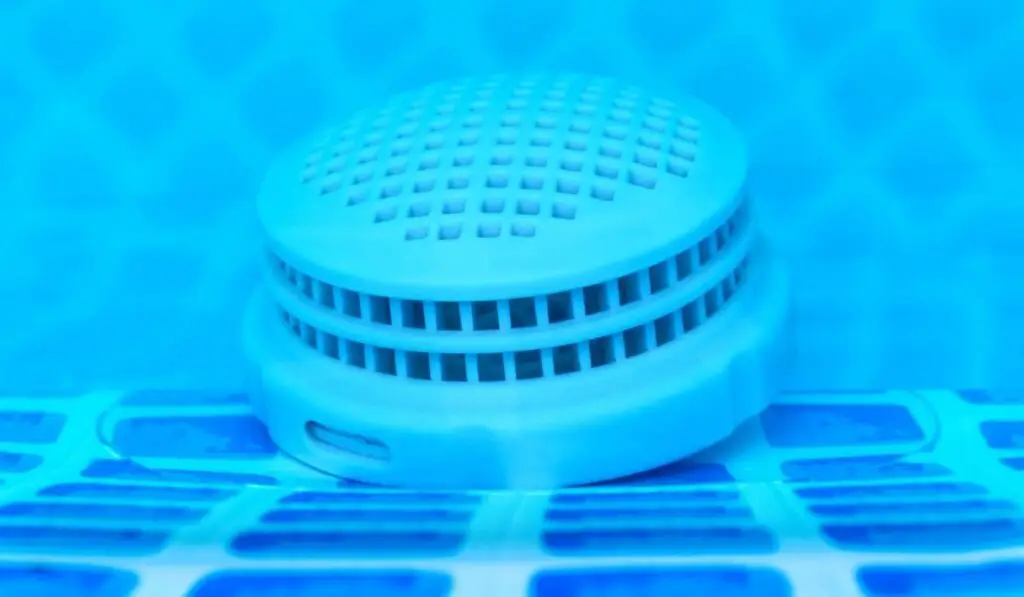If you’ve ever been left without running water in the house due to a natural disaster or another emergency, you might have panicked about where your next drink of water would come from. Those with a swimming pool might have even considered the possibility of drinking water from it. However, pools have much more in them than just water, so is it safe to drink from them?
Technically, it’s probably fine for you to drink small quantities of clear pool water in an emergency. Pool water contains other chemicals and bacteria that can be dangerous. There are some ways to purify pool water to make it safer for consumption such as filtering, distilling, or boiling it.
If you’re ever in a situation with limited access to water, it’s good to know exactly what to do and whether to consider drinking pool water. Let’s take a closer look at whether pool water is safe to drink and how you can make it safer if you need to.
Can You Drink Water From a Swimming Pool?

Swallowing a mouthful of pool water likely won’t hurt you. You’ve probably even done so accidentally while swimming previously and suffered no ill effects.
However, it’s not the best idea to fill a flask up and drink it as if it’s regular tap water. Pool water has many chemicals in it that can be harmful in large quantities, chlorine being the main one. So, if you can avoid drinking pool water, it’s best to drink water from any other source. Many people store bottled water in their house in case of emergencies, and that’s a much safe option.
If you do drink pool water and start to feel sick afterward (or have any side effects such as blurry vision, muscle weakness, etc.), it’s important to seek medical attention immediately. And, it’s worth saying that, in this context, if you need to consider drinking pool water, know that if the water is not clear, there’s no conversation to have at all here: if it’s cloudy or green, don’t drink it. Don’t even consider it.
All that said, there are some ways to make pool water safe to drink.
Chemical Composition of Pool Water
The chemicals in pool water are what make it unsafe to drink, so let’s take a closer look at them and whether they’re especially bad for you or not.
Chlorine
Chlorine reacts with water to form hypocholorous acid. It’s the acid’s job to attack bacteria cells in the water and kill them off, thereby keeping the water clean and making it safe to swim in. However, if you swallow a lot of this, the acid is going to attack your cells as well as the bacteria in the pool.
Potential signs of chlorine poisoning can include minor symptoms such as irritated eyes and a rash, as well as more serious ones like muscle weakness, blurry vision, and vomiting.
That’s why it’s important to see a doctor if you have any of these signs after ingesting pool water. Those with asthma or other respiratory problems may be particularly aggravated by chlorine poisoning.
Chloramines
When the acid created by chlorine interacts with ammonia, chloramines are what is created. They mainly irritate mucus membranes, even if they’re only inhaled.
Bromide
Some people choose to use bromide in their pools instead of chlorine. If you’re one of these people, don’t make the mistake of thinking it’s any safer. Just as it works the same way chlorine would, it would have the same effect on your body if ingested.
Ammonia
Although no one puts ammonia in the pool deliberately, debris and algae in the pool can interact with the chemicals to create ammonia — which is part of the reason it’s important to regularly maintain your pool.
Although ammonia shouldn’t cause too much irritation in very small quantities, it becomes even more important not to drink the water if it hasn’t been maintained because there may be a lot of ammonia, and it’s dangerous.
Cyanuric Acid
Pool conditioner — more formally known as cyanuric acid — helps to stabilize the chlorine. It’s not toxic to drink but will irritate your insides if consumed in large quantities, much like many of the other things in a pool.
Saltwater
Is a saltwater pool a safer source of water than a normal pool? The first thing to know is that saltwater pools still need all of the above chemicals, like chlorine, to keep them clean, so just because a pool is saltwater doesn’t make it safe to drink from.
Even drinking pure saltwater on its own isn’t great for you. Humans just aren’t meant to consume too much salt, and there’s more than you might expect in saltwater.
Again, small quantities probably aren’t bad for you, but too much could upset your insides quite a bit. It’s also probably not as hydrating as you think, since the salt almost cancels out the water content.
Algae
If you haven’t been cleaning your pool properly, algae will start to settle in and that’s going to attract insects. Mosquitos in particular love algae, so you shouldn’t put this water anywhere near your mouth if there’s algae in it!
There are many different types of algae. The most common is green algae, which is unpleasant but not toxic. Blue-green algae is the most toxic kind and should not be consumed under any circumstances, not even by dogs.
It’s important to clean your pool because blue algae is pretty resistant to the typical chlorine levels of a pool, and you may need to shock your pool by adding more chlorine if you see it.
Human Bacteria
It’s not just algae that may settle after a period of no maintenance — bacteria is likely to settle in too. Think how many people have stepped into your pool. People sweat, shed skin cells, and may even be leaving mucus in the pool water.
When you drink it, it’s all going into your system, and that can’t be good for you.
This can be especially dangerous if someone who’s sick or has a contagious disease has been in your pool.
Other Damaging Elements
The truth is, a number of other things could end up in pool water, especially if the pool hasn’t been cleaned in a while. These might include:
- Dead insects
- Animal waste from wildlife
- Debris from around the yard
If you have a dog that likes to swim in your pool, there might even be dog hair and saliva in there — more things that aren’t safe to consume. Animal waste can also contain a whole variety of different diseases, so there’s more to worry about than chemicals all of a sudden.
These are all things you don’t want to consume, so it’s generally not a good idea to take a big swig of pool water, even if the ill effects aren’t immediately visible. The CDC points out that viruses such as giardia are found in pool water. If you thought that only affected dogs and cats, think again! Other possible viruses you can get include:
- E. Coli
- Norovirus
- Cryptospordium
Although these are all treatable, they can be very unpleasant to suffer from and come from all different kinds of bacteria.
How to Purify Swimming Pool Water for Drinking

If you’re in dire straits and really need to drink some pool water, there are a few steps you can take to make it safer.
Filter
You can buy a good water filter (on Amazon) to get rid of the bacteria and make the water clean again. In a pinch, you can also use tightly-woven fabric to filter the water out, though you should make sure there are several layers. This isn’t perfect by any means, so don’t consume too much of the water if possible, but it should at least filter out the large bacteria present in the water.
Distilling
A water distiller (on Amazon) is another great way to clean out the water. This is the process of separating the chemicals from the water by evaporation. The water evaporates into the air and the distiller catches the evaporated steam and converts it back into water.
Boiling
Boiling water is another great way to distill it, as it will quickly get rid of the chemicals and you can collect the evaporation. If you don’t have a device to distill the water, this is the way to go.
Dechlorinators and UV Rays
If you want to dechlorinate the water to begin the process to make it safer to drink, you can buy a dechlorinator (on Amazon) or simply let the sun do its job.
A dechlorinator will quickly get rid of the chlorine in the water. However, if you don’t have this tool on hand or can’t get one online, the sun serves a similar function.
The UV rays will remove the chlorine from the water. Always make sure to test the chlorine level and ensure the pool isn’t automatically adding more while the sun does its job.
You’ll also have to neutralize the pH level, so make sure you buy some pH test strips (on Amazon) and check the levels before you ever let that water enter your body. It’s best to constantly have some of these on hand, as you never know when you might need them.
If you’re letting nature take care of the chlorine rather than getting rid of it using chemicals, you can expect the process to take up to a week. If you want drinking water in a hurry, this likely won’t do the job, but it’s worth noting for the future.
What to Do if You Drank Pool Water by Accident
If you drank pool water without realizing it wasn’t safe and are only now just concerned, don’t panic. If some time has passed and you haven’t felt any ill effects, you’re probably fine — especially if your pool is well-maintained and you only consumed a small amount.
You should, however, keep an eye out for the possible signs of chemical poisoning or a sign you’ve consumed too much bacteria:
- Feeling nauseous
- Pain in the stomach
- Blurry vision
- Muscle weakness
- Chest tightness
- Irritation anywhere
- Diarrhea
If you do have any of these signs, seek immediate medical attention. A little pool water shouldn’t harm you, but if you have pre-existing conditions or you consumed too much, you might feel the ill effects.
It might also be your dog that drank pool water and you’re concerned about them. Dogs have strong stomachs, so don’t worry too much — it’s pretty normal for them to swallow a mouthful of pool water when they dive in.
Just like humans, however, they shouldn’t consume too much, so provide plenty of fresh water to discourage them and never, ever let them enter a pool with blue-green algae on the surface.
